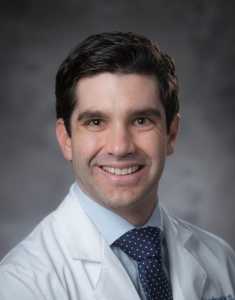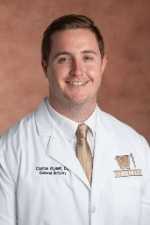Hypoglossal Nerve Stimulator
Abstract
Obstructive sleep apnea (OSA) is a common condition with several effective treatment strategies centered around relieving airway obstruction. The gold standard for OSA treatment remains continuous positive airway pressure (CPAP), but other options exist. A recent therapy developed within the past decade utilizes hypoglossal nerve stimulation (HGNS) through a surgically implanted device. As the patient inspires, the device sends an electrical impulse similar to a cardiac pacemaker. The impulse activates targeted branches of the hypoglossal nerve, leading to stimulation of muscles that protrude the tongue and open the airway posteriorly. This mechanism has been shown to reduce airway obstruction by activating these muscles during inspiration. Along with detailing the chronological order of events, this case outlines various complex anatomical structures that are identified in order to safely and effectively implant the hypoglossal nerve stimulator. Please note that an update device and surgical procedure have since been developed, and that this specific video article addresses the original device and surgical technique. The updated procedure is an FDA-approved alternative to this 3-incision technique, where the device is implanted through 2 incisions.
Case Overview
Background
Obstructive sleep apnea (OSA) is characterized by repeated bouts of hypopnea or apnea secondary to upper airway collapse that occurs during sleep. Episodes of obstructive respiratory events not only disrupt sleep patterns, but may also result in chronic hypoxemia leading to an overactive sympathetic nervous system, endothelial dysfunction, and oxidative stress throughout the body.1 Due to these pathologic effects, OSA is associated with a myriad of chronic health conditions including obesity, hypertension, heart failure, atrial fibrillation, stroke, and type II diabetes.2,3 The prevalence is currently estimated to be nearly a billion people across the globe, with the United States having one of the highest rates of disease.4 There is a role for a multitude of treatment options given the large number of individuals affected by OSA.
Despite a multifactorial contribution, one primary component in many cases of OSA is the decrease in pharyngeal muscle tone that occurs during sleep.5 Treatments are focused on the different methods to counteract this obstructive process. The established gold standard treatment for OSA is continuous positive airway pressure (CPAP).6 CPAP does effectively alleviate OSA; however, adherence rates are frequently poor, with long-term adherence estimated between approximately 30–60%.6 Due to the relatively low adherence to CPAP and high disease prevalence, there have been persistent efforts made to develop alternatives to CPAP. These include nasal, oral, and oropharyngeal surgeries, or combinations of multiple sites. Success rates for these procedures, even in a multilevel setting, have not replaced CPAP as standard therapy. Hypoglossal nerve stimulation (HGNS) is a relatively new alternative used in patients with moderate to severe OSA who fail CPAP therapy.7
Focused History
Given that failure of CPAP therapy is required in order to meet the criteria for hypoglossal stimulation, the patient will likely be referred from a sleep specialist with a diagnosis of OSA. Nevertheless, it is important to recognize the symptoms, as an established baseline may help when determining the effectiveness of the treatment following the operation. Individuals with OSA can present with symptoms occurring during the daytime and nighttime. Common nocturnal symptoms include snoring, nocturnal gasping/choking, or difficulty staying asleep. Daytime symptoms most notably include sleepiness or fatigue, headaches, memory impairment, or difficulty concentrating.5 However, patients may present with no complaints at all because they were referred to the clinic by a significant other who noticed loud snoring or periods of gasping for air while asleep.
Physical Exam
A thorough physical exam may assist in ruling out other abnormalities that could be contributing to a patient’s symptoms. Patients may present with elevated blood pressure, as there is an association between hypertension and OSA.8 Body habitus is something to take note of during the exam. Obesity is not only a risk factor for OSA, it may prevent the patient from being a candidate for this surgery due to abnormal anatomy diagnosed during the preoperative endoscopy.9 Drug-induced sleep endoscopy (DISE) is performed in order to evaluate the soft palate and determine if the airway anatomy is suitable for the procedure. This is discussed in further detail under Special Considerations.
Natural History
Currently, HGNS is only approved for adult individuals. However, it is important to note that OSA can occur at any age. Key pediatric risk factors for OSA include obesity, adenotonsillar hypertrophy, craniofacial abnormalities, and neuromuscular disease.10 Longitudinal cohort studies in adults have shown that a recent increase in weight correlates with a higher chance of developing OSA.11
Treatment Options
CPAP is the first-line therapy in individuals with OSA.12 In individuals with mild to moderate OSA who cannot tolerate CPAP, there is an option to try an oral appliance worn at night. Oral appliances generally reposition the mandible anteriorly in an attempt to open the airway.8 Other than hypoglossal stimulation, surgical options include uvulopalatopharyngoplasty (UPPP), tonsillectomy and adenoidectomy (commonly in children), tongue base procedures, and maxillomandibular advancement.8,9 Patients may experience improvement with lifestyle changes such as exercise and weight loss.12
Rationale for the Treatment
HGNS is an alternative option for select OSA patients that either cannot tolerate or fail to improve on CPAP therapy.7 The goal of this treatment is either a resolution of disease or reduction in disease severity measured by the Apnea-Hypopnea Index (AHI).
Special Considerations
Hypoglossal stimulation is FDA approved for patients age 18 and older that have failed or are unable to tolerate CPAP therapy.13 Patients must also meet several other criteria to be approved for device/surgery coverage. These include severe OSA determined by AHI of 15–65, a central apnea index < 25% of the AHI, a BMI ≤ 32, and a drug-induced sleep endoscopy (DISE) without evidence of complete concentric collapse.7 The patient must also have anatomy that is suitable for the procedure. Given that the target of hypoglossal stimulation is tongue protrusion via the action of the genioglossus muscle, the type of airway collapse is crucial. A DISE is done during the preoperative period in order to examine the anatomy and determine the type of airway collapse. Either retropalatal or anterior-posterior airway collapse is preferred, as this has been shown to respond well to hypoglossal stimulation. Patients with complete concentric collapse at the level of the velopharynx, or soft palate, are not candidates for the procedure because the degree and nature of collapse is too severe to overcome by hypoglossal stimulation.14 Other contraindications include central or mixed apnea noted on 25% of the total AHI, lack of upper airway control due to prior surgery or neurologic condition, patients unable to operate the equipment, pregnancy, and patients who need certain types of MRI.7,13 It is important to note that bipolar cautery is used whenever the device is brought onto the field, as monopolar cautery may damage the device.7
Discussion
This case begins with the placement of electrodes into the lateral tongue and inferiorly into the genioglossus muscle. The electrodes ensure that the correct branches of the hypoglossal nerve are stimulated with the device, with the ultimate goal being protrusion of the tongue achieved by genioglossus contraction.14 Following electrode placement, external anatomy is identified and marked in order to map out the three sites of the incision. Care should be taken to identify the external jugular vein as this can be at risk during the tunneling process. The procedure begins with identifying the hypoglossal nerve for placement of the stimulation lead. An incision is mapped out similar to that for a submandibular gland excision, two fingerbreadths below the body of the mandible to reduce risk to the marginal mandibular nerve. Once the hypoglossal nerve is isolated, coupling of the inclusion branches is done using neurostimulation with the aforementioned electrodes in the genioglossus muscle. The lead, containing inclusion branches, is subsequently secured into place. After the stimulation lead is in place, a pocket is made in the anterior chest wall for the generator, and a respiratory sensing lead is placed inferiorly in between the internal and external intercostal muscles. Once all three components are in place, the leads are then tunneled and connected to the generator. Finally, the device is tested extensively prior to closing.
When placing the NIM electrode, care should be taken to avoid the Wharton's duct. Attention should be given to avoiding the inclusion of the C1 nerve into the stimulation cuff and to the preservation of the Ranine vein.
The device is turned off during the initial recovery period as the patient heals. Approximately one week following the operation, sutures are removed, and the patient is cleared to return to activities of daily living with restrictions on strenuous upper extremity movements for the first month.7 From one month to three months following the operation, the patient’s device is turned on and titrated to the correct settings using polysomnography.14 The patient follows up every 5–12 months to ensure that the device is working appropriately.7
The HGNS in this case (Inspire, Minnesota, USA) received FDA-approval in 2014, having been used outside of the United States in years prior.15 Since then, studies have looked at the safety and efficacy of this therapy. From 2016 to 2018, the ADHERE registry collected data from 508 individuals regarding subjective and objective measures of OSA, for which they used the Epworth Sleepiness Scale (ESS) and AHI, respectively. Within one year, ESS improved by a median of 5 points and AHI dropped from a median of 34 to 7 events per hour according to values obtained through a titration study.16 Of note, out of the 508 individuals, there was a 2% rate of adverse events with the procedure. This included intraoperative bleeding that was controlled with pressure, seroma, transient dysarthria, and transient tongue weakness.16
Another notable study, the STAR trial, released five years of data in 2018 from a cohort of 97 individuals. The STAR trial resulted in similar improvement in both disease severity and quality of life.15 A recent study followed 20 adolescent individuals (median age of 16) with Down syndrome who were treated with hypoglossal nerve stimulation for refractory OSA. Two months following the operation, there was a median decrease in AHI of 85% in those individuals.17 In part to these results, the FDA recently lowered the approved age for this therapy from age 22 to age 18.13 In summary, it appears that evidence continues to build in the support for this surgical intervention in the treatment of OSA.
An updated device and surgical procedure have been developed since the filming of this video. The original device and surgical technique are portrayed here. The updated procedure is an FDA-approved alternative, where the device is implanted through 2 incisions instead of the 3 seen here.
Equipment
Inspire Upper Airway Stimulation System.
Disclosures
C. Scott Brown also works as editor of the Otolaryngology section of the Journal of Medical Insight.
Statement of Consent
The patient referred to in this video article has given their informed consent to be filmed and is aware that information and images will be published online.
Citations
- Javaheri S, Barbe F, Campos-Rodriguez F, et al. Sleep apnea: types, mechanisms, and clinical cardiovascular consequences. J Am Coll Cardiol. 2017 Feb 21;69(7):841-858. doi:10.1016/j.jacc.2016.11.069.
- Jehan S, Zizi F, Pandi-Perumal SR, et al. Obstructive sleep apnea, hypertension, resistant hypertension and cardiovascular disease. Sleep Med Disord. 2020;4(3):67-76.
- Muraki I, Wada H, Tanigawa T. Sleep apnea and type 2 diabetes. J Diabetes Investig. 2018 Sep;9(5):991-997. Epub 2018 Apr 14. doi:10.1111/jdi.12823.
- Benjafield AV, Ayas NT, Eastwood PR, et al. Estimation of the global prevalence and burden of obstructive sleep apnea: a literature-based analysis. Lancet Respir Med. 2019 Aug;7(8):687-698. doi:10.1016/S2213-2600(19)30198-5.
- Dempsey JA, Veasey SC, Morgan BJ, O'Donnell CP. Pathophysiology of sleep apnea. Physiol Rev. 2010 Jan;90(1):47-112. Erratum in: Physiol Rev. 2010 Apr;90(2):797-8. https://doi.org/10.1152/physrev.00043.2008.
- Rotenberg BW, Murariu D, Pang KP. Trends in CPAP adherence over twenty years of data collection: a flattened curve. J Otolaryngol Head Neck Surg. 2016 Aug 19;45(1):43. doi:10.1186/s40463-016-0156-0.
- Gupta RJ, Kademani D, Liu SY. Upper airway (hypoglossal nerve) stimulation for treatment of obstructive sleep apnea. Atlas Oral Maxillofac Surg Clin North Am. 2019 Mar;27(1):53-58. doi:10.1016/j.cxom.2018.
- Gottlieb DJ, Punjabi NM. Diagnosis and management of obstructive sleep apnea: a review. JAMA. 2020 Apr 14;323(14):1389-1400. doi:10.1001/jama.2020.3514.
- Wray CM, Thaler ER. Hypoglossal nerve stimulation for obstructive sleep apnea: a review of the literature. World J Otorhinolaryngol Head Neck Surg. 2016 Dec 22;2(4):230-233. doi:10.1016/j.wjorl.2016.11.005.
- Huang YS, Guilleminault C. Pediatric obstructive sleep apnea: where do we stand? Adv Otorhinolaryngol. 2017;80:136-144. Epub 2017 Jul 17. doi:10.1159/000470885.
- Punjabi NM. The epidemiology of adult obstructive sleep apnea. Proc Am Thorac Soc. 2008 Feb 15;5(2):136-43. doi:10.1513/pats.200709-155MG.
- Semelka M, Wilson J, Floyd R. Diagnosis and treatment of obstructive sleep apnea in adults. Am Fam Physician. 2016 Sep 1;94(5):355-60.
- Center for Devices and Radiological Health. Inspire UAS System. U.S. Food and Drug Administration. https://www.fda.gov/medical-devices/recently-approved-devices/inspirer-upper-airway-stimulation-p130008s039. Published April 14, 2020. Accessed February 23, 2021.
- Yu JL, Thaler ER. Hypoglossal nerve (cranial nerve XII) stimulation. Otolaryngol Clin North Am. 2020 Feb;53(1):157-169. Epub 2019 Nov 4. doi:10.1016/j.otc.2019.09.010.
- Woodson BT, Strohl KP, Soose RJ, et al. Upper airway stimulation for obstructive sleep apnea: 5-year outcomes. Otolaryngol Head Neck Surg. 2018 Jul;159(1):194-202. Epub 2018 Mar 27. doi:10.1177/0194599818762383.
- Heiser C, Steffen A, Boon M, et al. Post-approval upper airway stimulation predictors of treatment effectiveness in the ADHERE registry. Eur Respir J. 2019 Jan 3;53(1):1801405. doi:10.1183/13993003.01405-2018.
- Caloway CL, Diercks GR, Keamy D, et al. Update on hypoglossal nerve stimulation in children with down syndrome and obstructive sleep apnea. Laryngoscope. 2020 Apr;130(4):E263-E267. Epub 2019 Jun 20. doi:10.1002/lary.28138.




